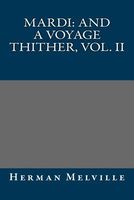- Welcome to FictionDB, Guest
- | My Account
- | Help

Mardi and a Voyage Thither — Herman Melville
Presented as narratives of his own South Sea experiences, Melville's first two books had roused incredulity in many readers. Their disbelief, he declared, had been "the main inducement" in altering his plan for his third book, Mardi: and a Voyage Thither (1849). Melville wanted to exploit the "rich poetical material" of Polynesia and also to escape feeling "irked, cramped, & fettered" by a narrative of facts. "I began to feel . . . a longing to plume my pinions for a flight," he told his English publisher.
Mardi began as a sequel to Typee (1846) and Omoo (1847), but changed radically while he was writing it and emerged as an altogether independent and original work. In its combination of adventure, allegorical romance, realistic portraits of characters and scenes from nature, philosophical speculation, and travelogue-satire, Mardi was Melville's first attempt to create a great work of fiction.
This edition of is an Approved Text of the Center for Editions of American Authors (Modern Language Association of America).
Mardi began as a sequel to Typee (1846) and Omoo (1847), but changed radically while he was writing it and emerged as an altogether independent and original work. In its combination of adventure, allegorical romance, realistic portraits of characters and scenes from nature, philosophical speculation, and travelogue-satire, Mardi was Melville's first attempt to create a great work of fiction.
This edition of is an Approved Text of the Center for Editions of American Authors (Modern Language Association of America).
Click on any of the links above to see more books like this one.




